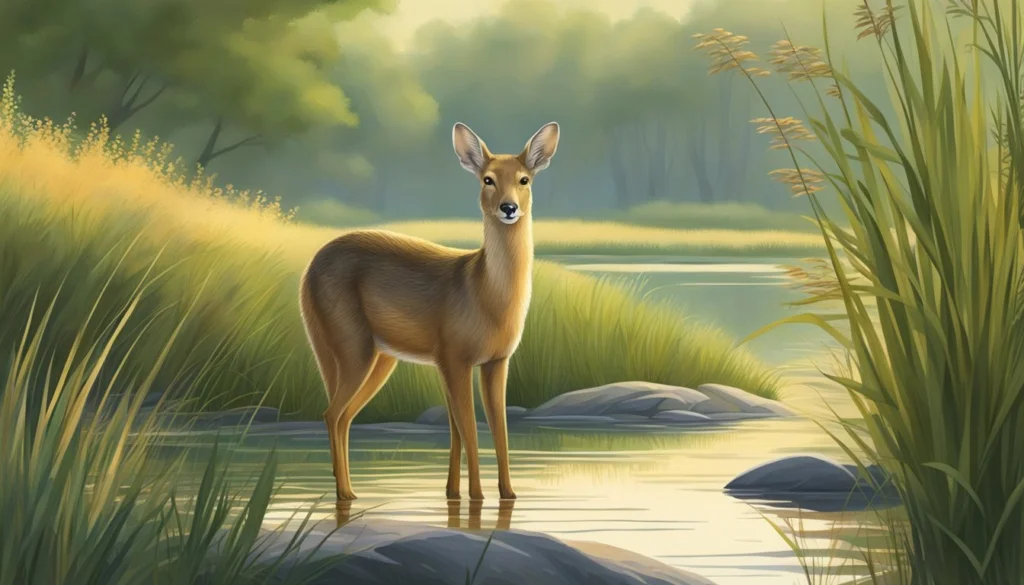The Chinese Water Deer (Hydropotes inermis), with its unique appearance and unusual behaviors, stands out among other deer species. Native to China and Korea, this small, fanged herbivore has intrigued scientists and animal lovers alike. Although less well-known than other deer species, the Chinese Water Deer has adapted to its environment in surprising ways. Let’s explore five fascinating facts about this distinctive species.
1. Vampire-Like Fangs Instead of Antlers
One of the most striking features of the Chinese Water Deer is its fangs. Unlike most male deer that grow antlers, male Chinese Water Deer have large canine teeth, often referred to as “tusks,” which can grow up to 2 inches long. These fang-like teeth give the deer an unusual, almost vampire-like appearance, but they serve a practical purpose.
The fangs are used by males during the breeding season to fight other males for territory and mates. Instead of locking antlers like other deer species, Chinese Water Deer slash at each other with their elongated canines. Despite their fierce appearance, these confrontations rarely cause serious harm.
Why They Have Fangs:
- No Antlers: Males lack antlers, unlike most deer species.
- Fangs: Canine teeth grow up to 2 inches long.
- Purpose: Used in territorial and mating battles between males.
2. Semi-Aquatic Lifestyle
As their name suggests, Chinese Water Deer are closely associated with wetland environments. They are often found near rivers, marshes, and reed beds where they can easily access water and dense vegetation for cover. Their semi-aquatic lifestyle helps them evade predators, as they are strong swimmers and can escape into the water if threatened.
Their habitats in the wild typically consist of low-lying areas with plenty of water sources, where they can forage on aquatic plants, grasses, and leaves. This preference for wetland environments has also earned them the nickname “water deer.”
Habitat Preferences:
- Wetlands: Thrive in marshes, riversides, and reed beds.
- Swimming Ability: Excellent swimmers, using water to escape predators.
- Diet: Feeds on grasses, aquatic plants, and leaves.
3. A Rare and Solitary Deer Species
Chinese Water Deer are not herd animals. Unlike many other deer species that live in groups, Chinese Water Deer are solitary creatures, especially outside the breeding season. Males are territorial and will aggressively defend their area from other males, particularly during the rutting season.
Females also lead solitary lives, though they are less territorial than males. After giving birth, female water deer are highly protective of their offspring and will choose secluded, well-hidden areas to rear their young, further emphasizing their preference for solitude.
Social Behavior:
- Solitary Animals: Prefer living alone rather than in herds.
- Territorial Males: Males defend their territory fiercely, especially during mating season.
- Protective Mothers: Females seek solitude to protect their young.
4. High Reproductive Rate
Chinese Water Deer have a remarkably high reproductive potential, often giving birth to larger litters than most other deer species. A typical litter can consist of up to six fawns, though two to three is more common. This high reproductive rate helps compensate for the many predators that target fawns, such as foxes, birds of prey, and even larger carnivores.
Female Chinese Water Deer have a gestation period of about six to seven months, after which they give birth in secluded, grassy areas. The fawns are born with a spotted coat that helps them blend into their environment, providing them with some camouflage from predators.
Reproduction:
- Large Litters: Can give birth to up to six fawns at a time.
- Gestation: Lasts six to seven months.
- Camouflaged Fawns: Spotted coats help newborns stay hidden from predators.
5. An Invasive Species in the UK
Although native to China and Korea, the Chinese Water Deer has established populations in the United Kingdom. This happened in the early 20th century when the species was introduced to Britain after escaping from wildlife parks and estates. Surprisingly, the species adapted well to the British countryside, particularly in areas with suitable wetlands and marshes.
Today, there are thriving populations of Chinese Water Deer in the UK, particularly in areas like Norfolk and Bedfordshire. Despite being an introduced species, they have not become invasive in the sense of outcompeting native wildlife, though they remain a curiosity among local fauna.
In the UK:
- Introduced Species: Brought to the UK in the early 20th century.
- Thriving Population: Adapted to wetlands and marshes in England.
- Non-Invasive: They have not significantly impacted native species.
Conclusion
The Chinese Water Deer is a truly unique species with features and behaviors that set it apart from other deer. From its fang-like tusks and solitary lifestyle to its impressive reproductive abilities and surprising presence in the UK, this small deer is full of fascinating surprises. Whether admired for its unusual appearance or its adaptability to different environments, the Chinese Water Deer is a remarkable example of nature’s diversity.
FAQ
Why does the Chinese Water Deer have fangs?
The fangs, or elongated canine teeth, are used by male Chinese Water Deer in territorial battles during the breeding season, replacing the need for antlers.
Where are Chinese Water Deer found?
They are native to China and Korea but have also established populations in the United Kingdom after being introduced in the early 20th century.
Are Chinese Water Deer dangerous?
No, despite their fangs, Chinese Water Deer are not dangerous to humans. The fangs are used only in battles between males for territory and mates.
How do Chinese Water Deer live in the wild?
Chinese Water Deer are solitary animals that prefer wetland habitats. They are strong swimmers and use water as a means of escape from predators.
How many fawns can Chinese Water Deer have?
Chinese Water Deer can give birth to up to six fawns, though litters of two to three are more common.
Are Chinese Water Deer endangered?
While not currently listed as endangered, Chinese Water Deer populations in their native range are declining due to habitat loss and hunting. However, they are thriving in introduced populations in the UK.


